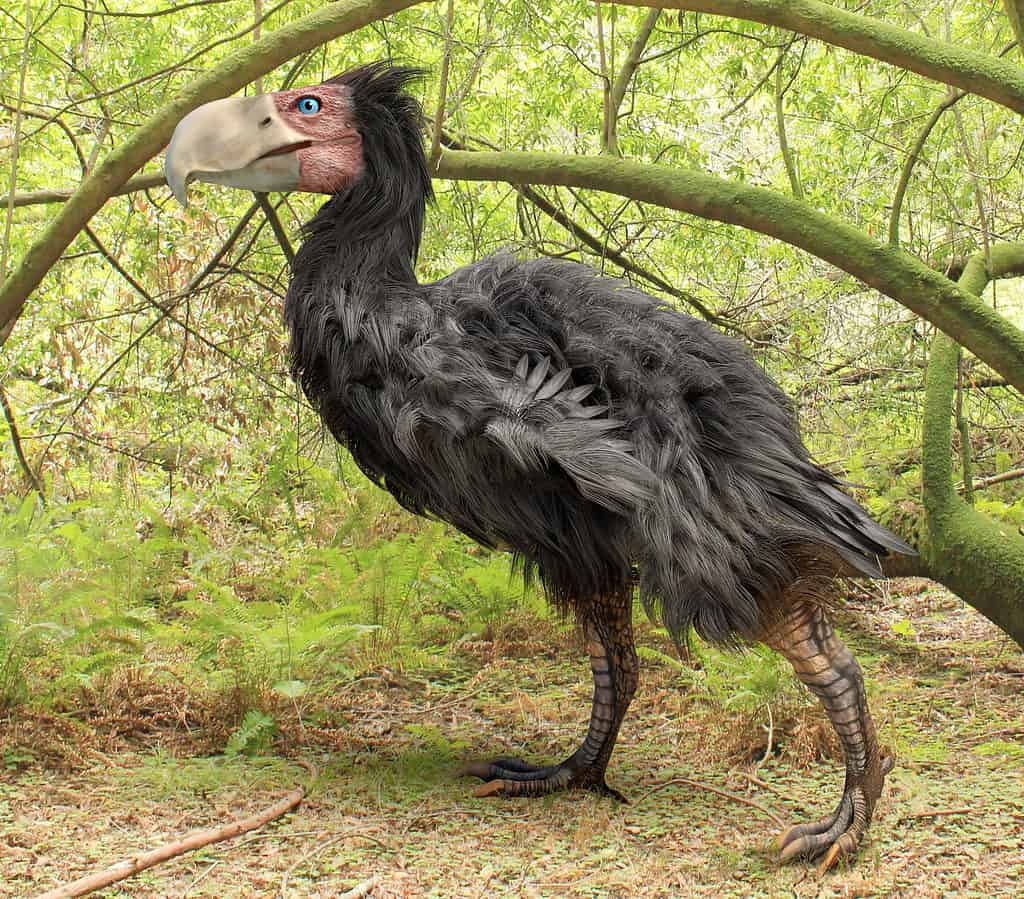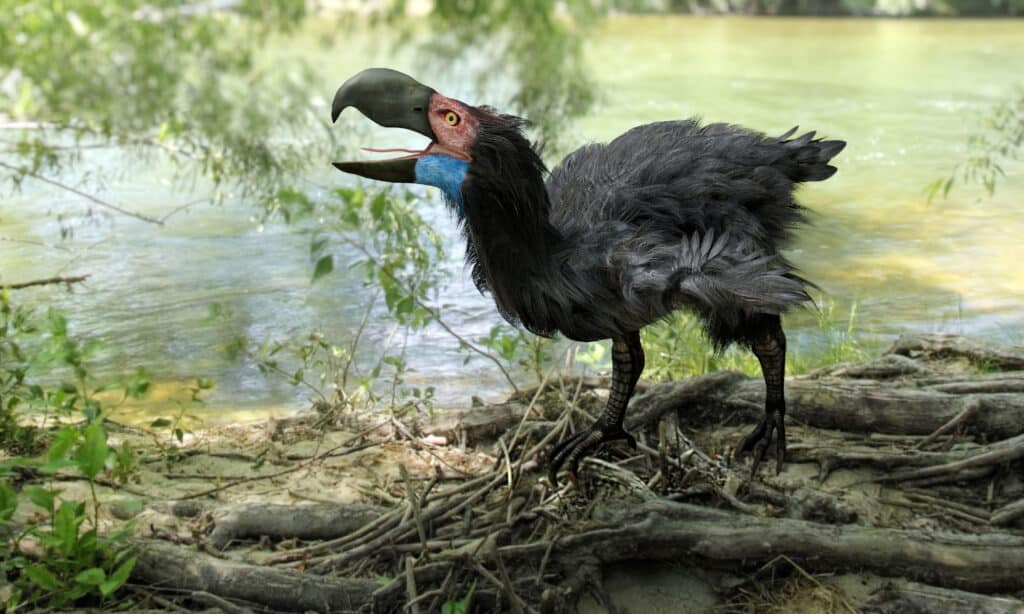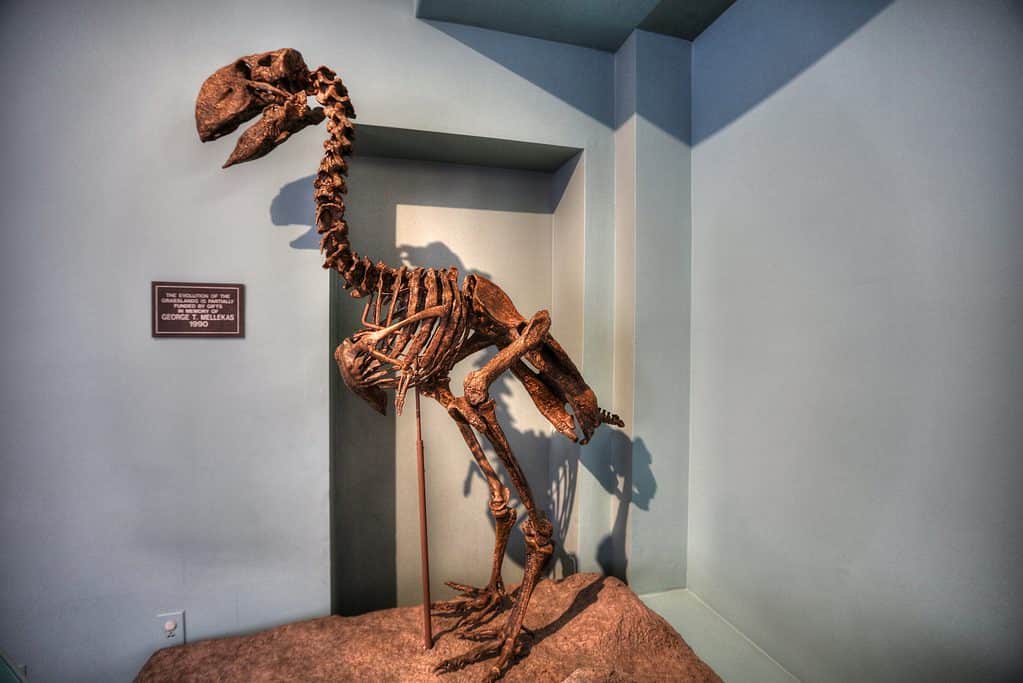There have been species of giant birds all throughout history. Even today we have species like the ostrich which can grow to almost 9 feet tall. But what do we know about giant prehistoric birds? Over the past 200 years, researchers have uncovered fossils of several species of Gastornis. The Gastornis is a giant bird that has had scientists scratching their heads for years. The large size, beak, and talons were once thought to belong to an apex predator but now it is believed the Gastornis was likely just a very large herbivore. Let’s meet the gigantic bird that was taller than a man.
What Did Gastornis Look Like?
The Gastornis was a very large species of bird that is known by its many fossils including a few almost complete specimens. Several species of this bird have been identified with the largest so far being Gastornis gigantea. This species grew up to about 6 and a half feet tall and its average weight was a little over 300 pounds.
The beak of the Gastornis was large and robust with some species having a hooked beak while others like G. gigantea had no hook. The body of this bird was powerfully built with thick sturdy legs and taloned feet. When the fossils were first discovered it was thought that the bird’s neck was very long putting its height at close to 8 feet tall. Further findings prove while their vertebrates are large they are condensed so the neck is much shorter than previously believed.

The beak of the
Gastorniswas large and robust with some species having a hooked beak.
©iStock.com/Aunt_Spray
Habitat and Diet of the Gastornis
Different species of Gastornis have been uncovered in several parts of the world. While most species have been found in western-central Europe there have also been species found in China and North America. Based on the time period they lived and areas they’ve been discovered these birds most likely lived in dense forests and woodlands.
The diet of this gigantic bird was once believed to be carnivorous. This was due to the hooked beak which is typically associated with carnivorous birds. It was thought the talons and hooked beaks were used to tear the flesh from its prey. However, the talons on the Gastornis are straight rather than hooked which are typically found on species of carnivorous birds.
Due to a study published in 2014 about the diet of the Gastornis, the diet of this species is now believed to be mainly if not exclusively herbivorous. While it was once thought to be an apex predator it is now known that that is highly unlikely. The Gastronis was too poorly equipped to be an apex predator. It is now believed that the large beak was used for tearing into tough vegetation rather than flesh.

The large size, beak, and talons of the
Gastornishad many thinking they were apex predators but now the belief is they were likely herbivorous.
©iStock.com/Aunt_Spray
Fossils and Discoveries of the Gastornis
The first fossils described were found in 1855 by Gaston Plante who is also who the bird has been named after. The first fossil was a fragmentary skeleton found in clay formation deposits at Meudon near Paris. Additional remains were discovered in the 1860s.
After the first few notable discoveries of this first known species Gastornis parisiensis several remains have been unearthed. Some fossils uncovered in the 1870s were the basis for the first widely known, incorrect, description of the Gastornis by Pierre Louis Victor Lemoine. It was discovered several bones used in his reconstruction were from other animals.
In 1916 the first nearly complete skeleton and skull of the Gastornis were discovered in the Bighorn Basin of Wyoming. This discovery gave scientists the first real look at what the giant bird once looked like. At first, the fossils discovered in America were classified as a separate species of giant bird known as Diatryma gigantea. These fossils were very similar to that of the Gastornis but due to Lemoine’s inaccurate depiction, made it difficult for scientists to accept their findings.

In 1916 the first nearly complete skeleton and skull of the
Gastorniswere discovered in Wyoming, giving scientists insight into its appearance.
© – License
Time Period and Extinction of the Gastornis
The Gastornis lived from the mid-Paleocene to mid-Eocene epochs of the Paleogene Period. They became extinct in the mid to late Eocene but the cause is currently unknown. It is often cited that competition with mammals may have caused a decline but that is widely debated.
The species of gigantic bird coexisted with many different megafauna forms making it unlikely that mammalian predators caused the extinction. It is also thought that the extreme climate shift like the Paleocene–Eocene Thermal Maximum had little to no effect on the Gastornis. It is likely competition with mammals and other herbivores caused a decline in population over time.
Up Next
- Emu vs. Ostrich: 9 Key Differences Between These Giant Birds
- This Gigantic Bird Had a 20 Foot Wingspan and a Terrifying Beak with Teeth
- Was This 5ft Prehistoric Bird an Egg Thief, or Not?
The photo featured at the top of this post is © Aunt Spray/Shutterstock.com
Thank you for reading! Have some feedback for us? Contact the AZ Animals editorial team.






